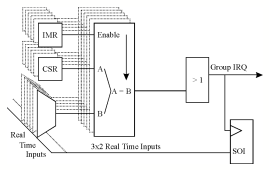
[Next]
[Previous] [Up] [Top] [Contents] [Back]3.2 Group Description
Each Group on the CC133 can generate an interrupt request, independent of the other groups. As described earlier in this section each channel has two possible interrupt sources: the Digital Inputs signal and the Index signal. A Group therefore has six interrupt sources. When any of the six input signals changes its level, an interrupt can be generated.
A special 'Compare State Circuit' is implemented on the CC133 to accomplish this function. The next figure shows how this circuit is functionally implemented.

Figure 3-4 Compare State Circuit
Several registers are implemented on the CC133 for generating and controlling of the interrupt capability. Each channel has the following interrupt control/status registers:
| Direct Input Register | |
| Compare State Register (CSR) | |
| State on IRQ Register (SOI) | |
| IRQ Mask Register (IMR) |
To detect a change in the input lines, the comparator must compare the 'Real Time' input lines with a copy of the previous state of the input lines. A copy is made of the current state of the input lines by reading the 'Direct Input Register', and this data should be written into the 'Compare State Register'. An interrupt will be generated as soon as the 'Real Time' input changes and the corresponding input is enabled in the 'IRQ Mask Register'. The current states of the Index and Digital Input signals are saved in the State On IRQ register at the time of the interrupt request. Each group has its own interrupt request signal to the Bus Interrupter Module.
Further detailed programming considerations are given in chapter 5.
![]()
[Next]
[Previous] [Up] [Top] [Contents] [Back]
![]()